1
George Campbell TinningCirca 1950s
Moose Jaw Museum & Art Gallery, Moose Jaw, Saskatchwan, Canada
 Credits:
Credits:Collection of the MJM&AG
2
It was Tinning's own initiative that led to him becoming a War Artist . In 1941, after joining the reserves, Tinning requested and received permission to produce a series of paintings at the Air Force base in Trenton, Ontario. The paintings he completed came to the attention of the Historical Section of the Canadian Army, which oversaw the War Art Program.3
Military Post, Sydney, NS1943
Moose Jaw Museum & Art Gallery, Moose Jaw, Saskatchwan, Canada
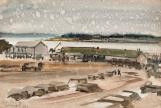 Credits:
Credits:Collection of the MJM&AG
4
In early 1943, based on the strength of this work, he was commissioned from the ranks and appointed an Official Canadian War Artist. His first assignment was to paint the activities of the Armed Forces in Nova Scotia and Newfoundland.5
George Campbell Tinning sketch of a soldier1944
Moose Jaw Museum & Art Gallery, Moose Jaw, Saskatchwan, Canada
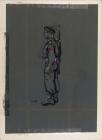 Credits:
Credits:Collection of the MJM&AG
6
When George Campbell Tinning travelled to Newfoundland, Canada's newest province, he was eager to get to work painting. His first brief visit had been for a few weeks from late August to early September 1943, when he was sent there as part of his War Artist duties.He had a terrible cold while there, but in spite of this he loved the people, and the look of the place, and he made many paintings of the harbour, fortifications, parade grounds, and other subjects related to the war.
7
Tinning enjoyed his stay in Newfoundland and requested and extension to stay longer. Unfortunately, this request was denied.8
George Campbell Tinning's painting of his studio1952
Moose Jaw Museum & Art Gallery, Moose Jaw, Saskatchwan, Canada
 Credits:
Credits:collection of the MJM&AG, 20.07.18.6
9
Tinning was released from the Army in 1946, and went back to his life as an artist and illustrator in Montreal. Beginning in 1938, he had worked in his studio, making a living doing various commercial art and graphic design jobs while teaching painting classes in the evenings.10
July-August issue of Lincoln-Mercury Times containting George Campbell Tinning paintings of NLJuly-August, 1951
Moose Jaw Museum & Art Gallery, Moose Jaw, Saskatchwan, Canada
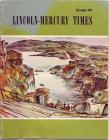 Credits:
Credits:archives of the MJM&AG
11
During this period, he worked for Simpson's Department Store, Ford Motor Company, and many other large and small clients. A commission from Ford helped him go to Newfoundland, as they used his paintings to illustrate an article in their company magazine, the Lincoln-MercuryTimes.12
Hibbs Cove, NL1949
Moose Jaw Museum & Art Gallery, Moose Jaw, Saskatchwan, Canada
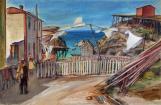 Credits:
Credits:Collection of the MJM&AG
13
Port de Grave, NL1949
Moose Jaw Museum & Art Gallery, Moose Jaw, Saskatchwan, Canada
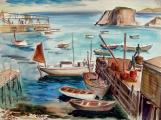 Credits:
Credits:Collection of the MJM&AG